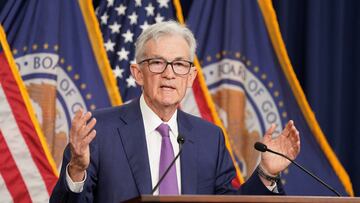FINANCE
2024 Mortgage Rate Forecast: Here’s how the Federal Reserve’s policies could affect your home loan
The Federal Reserve maintains rates in the target range of 5.25% to 5.5%, as announced this Wednesday.

The Federal Open Market Committee (FOMC) of the United States Federal Reserve announced earlier this month that it would not change the federal funds rate. The current rate range is between 5-1/4 and 5-1/2, the highest level since January 2001. A higher federal funds rate means those seeking loans from other lenders will see higher interest rates tacked on to their loans. For example, if you are in the market for a home and will require a mortgage, the rate offered has to account for the federal funds rate, and any additional percentage points the lender adds on to cover their own financial risk.
When announcing that no changes would be made to the federal funds rate in early May, Federal Reserve Chair Jerome Powell emphasized that he would continuously monitor the incoming information to evaluate the appropriate monetary policy stance taken by the central bank. He also added that he would be willing to adjust the bank’s monetary policy if any risks may hinder the achievement of objectives to maintain conditions for full employment and stabilize prices. Under Powell’s leadership, the US central bank raised interest rates consecutively eleven times between March 2022 and July 2023 to combat the rising cost of living.
The impact on the mortgage market
The Fed has justified maintaining a high-interest rate environment by pointing to continued economic uncertainty and the trend of price increases, even though the growth has slowed. In late April, the Bureau of Economic Analysis (BEA) at the US Department of Commerce reported that the personal consumption expenditure price index, the Fed’s preferred measure for tracking inflation, was at 2.7 percent year-over-year in March. This figure is two-tenths higher than the previous month of February. This figure is also higher than the inflation metric developed by the Bureau of Labor Statistics (BLS), the Consumer Price Index, which places the year-over-year rate at 3.4 percent.
A high federal fund rate impacts the rate of housing construction as developers are less inclined to take on new projects if they have to borrow in a high-rate environment. This can drive construction down when an increase in supply is needed to bring prices down. Currently, the housing supply is very low, which means that buyers are competing, pushing prices up as those in the market out bid each other.
The continued increases in the CPI and the PCE have altered many forecasts for mortgage rates in 2024. Many experts had expected inflation to soften further, which would provide the Fed with evidence that the federal funds rate could begin to come down. With the Fed opting to keep the rate at its current position, mortgage interest rates have been rising. Nevertheless, the last two weeks have seen rates fall as price increases have slowed. Freddie Mac’s Chief Economist, Sam Khater, released a statement on 16 May, noting that “the news that inflation eased slightly, [led] the 10-year Treasury yield [to dip], leading to lower mortgage rates,” over the last two weeks. Though Khater was quick to mention that the sign is “small” and that the trend could reverse, any decrease in the average cost of a mortgage provides “a bit more wiggle room in the budgets of prospective homebuyers.” On Thursday, 23 May, last week’s mortgage rates will be published, allowing Khater to better evaluate this trend’s stability.
When is the next FOMC meeting?
The FOMC is set to meet again in mid-June. Before then, the BEA will release the PCE report for April and the May Employment Report published by the BLS. Mortgage rates will only come down if two conditions are met. The first is a reduction in the federal funds rate, and the second being increased lender confidence in the market. Even if the Fed begins to lower interest rates, lenders will need to be confident that they are not exposing themselves to major risks if lower rates are offered. Speaking with Forbes, Melissa Cohn, the regional vice president for William Raveis Mortgage, said she expected mortgage rates to fall by two percent by the end of next year. A two percent cut would represent a significant decrease but still would keep rates on 30-year fixed mortgages well above their pre-pandemic levels.






